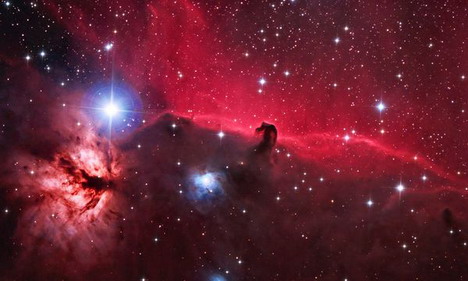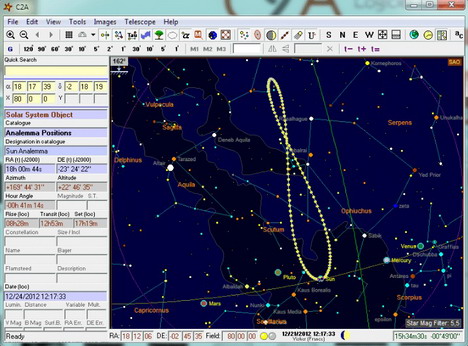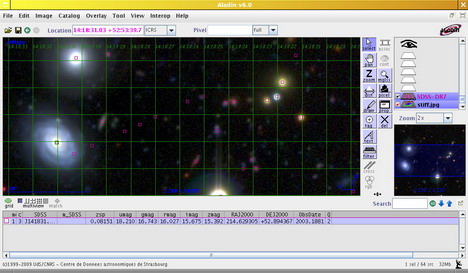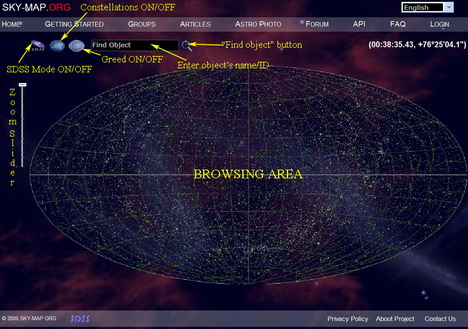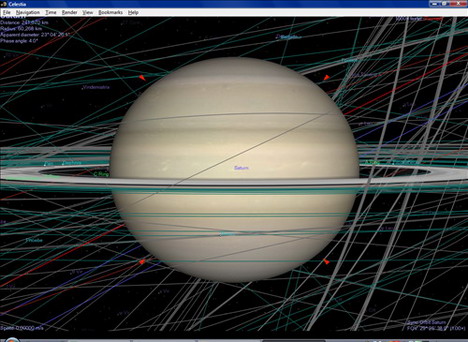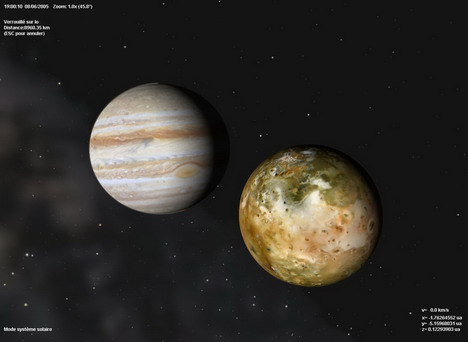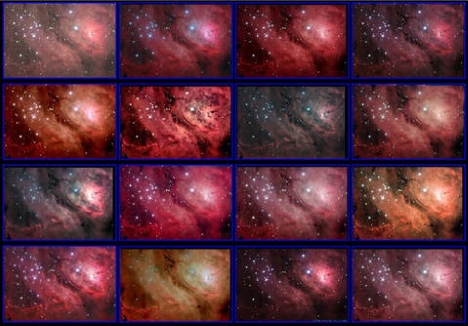Astronomy is a natural science that’s all about the earth and the universe. While it’s a broad research field driven by professional scientists around the world, it’s also a personal hobby of many who are interested in the study of celestial objects such as stars, moons, planets, nebulae and galaxies. Beside of using your naked eyes, binocular or telescope to obverse these fascinating sky objects, you can also make use of some astronomy software to help you access the mystery of space.
Today we’ve compiled an ultimate list of astronomical software, programs and online tools that help your work and hobby become more effective and interesting. These softwares are suitable to both professional and amateur astronomers and the best part is that they are all free to use!
Stellarium is an open sourced planetarium software that puts the night sky on your computer screen. Stellarium is an immersive experience based on astronomy that allows users to explore the stars, planets, constellations from virtually any place on Earth and at any time in the past, present, or future. Overall, Stellarium’s easy-to-use interface is user friendly and allows us to quickly navigate the night sky using the zoomable sky map, powerful search feature, or even the databases that are built in. Whether you are an experienced astronomer or just getting started, Stellarium offers users a valid option for exploring and learning more about the stars, planets, and other wonders of the universe.
The Sloan Digital Sky Survey (SDSS) is arguably the most ambitious and influential astronomical survey ever undertaken. It has resulted in the most detailed three-dimensional maps of the Universe, taken deep multi-color images of a third of the sky, established spectra for over three million astronomical objects, and formed the basis for studies on the large-scale structure of the Universe, the distribution of galaxies, the nature of dark matter and dark energy, and much more. SDSS has involved 200 scientists from 25 institutions, and it is an ongoing data resource for astronomers worldwide.
Home Planet is multi-faceted astronomy software created by John Walker. This free software provides features for the novice amateur astronomer to explore the night sky from one’s own home. Users can see a variety of quality star maps, track celestial bodies, and simulate the sky from anywhere on Earth, anytime, given a date and time. Users are also allowed to see all kinds of different objects in the solar system, all the constellations, and many deep sky objects. Also included are ceratin features to track, or simulate telescope and spacecraft. With a user friendly interface and many features that can be operated simply and powerful, Home Planet is a useful software for any novice or advanced astronomer.
C2A (Computer Aided Astronomy) is a full-featured planetarium software program for both amateurs and professionals developed by Philippe Deverchère. C2A has many features available to explore the night sky. Using the software’s easy-to-use interface, users can simulate the sky for any location anywhere in the world at any time, generate a detailed star chart, and follow the path of celestial objects such as stars, planets, comets, and asteroids. In addition to these amazing features, C2A has several telescope/control features, the capability to assist in planning your astrophotography, and tools for the analysis of data it generates. For those who wish to plan their evening and add to their enjoyment of stargazing while looking more closely at what they see and objectively study the cosmos, C2A is a very helpful tool.
Aladin Sky Atlas is a robust interactive sky atlas that provides the opportunity to visualize astronomical images, surveys, and catalogs. Aladin, developed by the Centre de Données astronomiques de Strasbourg (CDS), provides access to many collections of astronomical data from multiple resources, including space missions and ground-based observatories. Aladin allows the user to visualize the sky at various wavelengths, overlay various datasets upon each other, and identify and retrieve detailed information about celestial objects. Aladin is a powerful tool that frequently employed by astronomers and other interested parties for scientific, educational, and outreach related purposes.
Gaia Sky is an interactive astronomy software that is simply impressive. It is user-friendly 3D representation of the universe that allows users to explore what is mapped by the Gaia mission from the Astronomisches Rechen-Institut (ARI) Heidelberg University. The Gaia mission is currently mapping several billion stars in our galaxy. This data gives us an incredible 3D representation of the Milky Way and beyond where users can travel through stars, planets, and other celestial bodies with intuitive navigation and seemingly top-tier graphics. This software is extremely valuable for students, amateur astronomers and professionals alike.
Orbiter Space Flight Simulator is a realistic space flight simulation program, which allows the user to experience the trials and tribulations of space travel. Dr. Martin Schweiger’s simulator accurately simulates the physics involved in spaceflight. It incorporates orbital mechanics, gravity, spacecraft and other systems. Users can pilot many vehicles from an actual Space Shuttle to a fictional interstellar vessel and explore our solar system and beyond. Orbiter can be utilized as an educational resource for learning the art of space exploration, can be used by individuals new to space flight, and is used by professionals engaged in mission planning or spacecraft design.
Google Earth is an impressive utility because it is a different representation of a planet and the universe as a whole. Although Google Earth is known for showing detailed maps of the earth, it also has a feature called Sky mode, where users can explore space. A user can see stars, constellations, galaxies, and other celestial objects, as well as guided tours of the night sky. The ease of use, along with the enormous library of images, provide a great tool for a novice astronomer.
NASA World Wind is an open-source virtual globe application that allows users to discover the Earth and other planets in remarkable detail. NASA’s World Wind displays high-resolution images from satellites, topography maps, and 3D terrain of Earth, Mars, Venus, and the Moon. Ultimately, NASA World Wind will be useful to educators, scientists, and enthusiasts who have an interest in planetary science and exploration.
KStars is planetarium software for the desktop that is created by the KDE team. KStars provides a faithful recreation of the night sky from any location on Earth at any time, with a deep catalog for stars, planets, moons, asteroids, and comets, as well as tools for star gazing and documenting celestial objects. The open-source project is designed for both the novice researcher and the seasoned astronomer, KStars has a number of features to support sky viewing.
SkyChart, or Cartes du Ciel, is very popular and capable planetarium software that let’s you view the night sky from anywhere on earth. This free software comes stock with a considerable database of stars, planets, galaxies and all sorts of celestial objects, so it is perfect for astronomers or the casual star gazer. In addition to allowing users to create sky maps, track positions of celestial objects, and see their motion over time, SkyChart supports object identification of stars, constellations, and deep-sky objects making it very easy to learn about what you are looking at in the night sky. Overall, SkyChart/Cartes du Ciel is very comprehensive, simple to use, and an excellent program for those new to astronomy and those who are experienced.
Virtual Moon Atlas is software for observing and studying the Moon. This software is free for everyone to use and comes with maps showing the Moon in detail allowing users to explore craters, mountains, etc. VMA has a ton of information about the Moon including the site of all lunar landings, the locations of lunar formations, and other points of interest on the Moon surface. It also contains tool sets to simulate lunar eclipses and lunar events which is useful for amateur astronomers and lunar explorers. Overall, VMA is a great software for exploring Earth’s natural satellite.
Virtual Planets Atlas is a free software package that allows users to explore the planets of the solar system in detail. Virtual Planets Atlas includes high quality maps of planets, surface features, atmospheres, and moons. Virtual Planets Atlas also includes information about the locations and orbits of the planets, which makes it suitable for examining planetary motion. It allows you to monitor the position of planets in real-time and simulate their trajectory across the sky, so you can also learn about how the planets move. Virtual Planets Atlas provides a significant amount of information for understanding and exploring the planets of our solar system.
WikiSky.org and Sky-Map.org are two websites that have interactive sky maps and astronomical information, allowing users to observe the night sky using only a web browser. These sky maps are available to anyone who has an internet connection—anywhere on the earth! Both sites contain detailed information about stars, planets, galaxies, and other celestial objects, and they are useful for amateur astronomers and stargazers alike. Users can explore the sky, zoom into specific objects, and view detailed information about each object included in the site. WikiSky.org and Sky-Map.org are excellent tools usable by any user interested in astronomical information.
WorldWide Telescope is a powerful virtual telescope software that enables users to explore the universe using their computer. This free software provides high-resolution pictures of the night sky, featuring every star, planet, galaxy, and other kinds of celestial bodies you could imagine. While exploring the capabilities of WorldWide Telescope, you can fly around the most interesting parts of the sky in real time, zoom in on objects of interest, and read detailed facts about each object in Wikipedia-style detail. In addition to the thousands of astronomical catalogs, guided tours, and educational material, WorldWide Telescope is an impressive and functional piece of planetarium software that provides an incredibly fascinating view of the universe.
Celestia is open-source, free-to-use space simulation software that lets you explore the universe in three dimensions. Celestia is compatible with Windows, Mac OS X and Linux. Celestia offers users opportunities to travel through the solar system, fly to star systems that are light years away, and look at galaxies that are millions of light years away. It contains real astronomical data that accurately model the position and motion of objects in space. Users have the ability to add their own spacecraft and planets and even stars.
Hello Northern SKY (HN Sky) is an all encompassing planetarium application written for the amateur astronomer to explore the night sky, at any time from any place on the earth. Really both literally and conceptually HN Sky includes a detailed and accurate star catalog with a comprehensive list of information about stars, planets, and other celestial objects. Users can simulate astronomical events such as eclipses, conjunctions, and transits, as well as thoroughly using various choices of view and setting options. HN Sky can be helpful to learn about the night sky and plan opportunities for observing.
SkyTools is an astronomy planning software that provides amateur astronomers with all the information they need to plan an observing session. It provides detailed information about any celestial object – where it’s located in the sky, rise/set/transit times, and visibility. SkyTools also provides observation logging tools, celestial event tracking and the ability to generate a custom star chart. It is Windows PC software and is used by amateur astronomers throughout the world.
CyberSky is an interactive and user-friendly planetarium software that allows users to explore the night sky from anywhere on Earth. It shows users the stars, planets, and other celestial objects that can be seen from their location at a given time and date, in detail. With CyberSky, users can find out the names of the objects, where they are located, and what they are, in addition to an abundance of information about the objects in the sky. CyberSky can also be used to see simulations of the sky at different times and dates to track how the sky changes.
Gpredict is an open-source satellite tracking software program that allows users to track artificial satellite positions in real-time. It is available for Windows, Mac OS X and Linux. Tracking algorithms account for its prediction of future positions of satellites based on their orbital parameters. Users can track individual satellites, as well as create lists of satellites that they would like to track. Predicting satellite passes, visualizing satellite orbits, and receiving updates from satellite tracking networks are a few of the additional features provided.
Winstars is open-source planetarium software that allows users to explore the night sky in detail. The software include a comprehensive star/planet/celestial body database, detailed 3D models of the solar system and beyond. Winstars also has a variety of things to use for exploring the sky including a powerful search engine, a time control to view the sky at different times/dates, and an interface to control telescopes for tracking celestial objects.
AstroGrav is a software program that is useful to both amateur and professional astronomers. The program allows users to simulate how astronomical bodies move and interact under the influence of gravity. AstroGrav can model many physical contexts including the motion of planets and moons in the solar system, and the dynamics of star clusters and galaxies. AstroGrav provides tools for visualization of simulations and for data analysis giving the user a good way to model problems involving celestial mechanics and plan future observations.
Voyager is an excellent and helpful astronomy software offering a complete tool box to explore the universe. There are excellent star charts that can be printed to help navigate the night sky. Voyager also has a database containing over 2.5 million stars, planets, or deep sky objects making it a priceless tool for amateur and professional astronomers alike. Voyager has a range of advanced features such as telescope control, astronomical calculations and creating customized observing lists.
Skygazer is an easy-to-use astronomy software application, it is perfect for beginner and casual sky watchers. The interface is simple to use, it allows the user to view and explore the night sky. Skygazer has over 100,000 stars, planets, or other celestial objects to add to the skyline. Other features include sky maps that show real-time placement of celestial objects, as well as guided tours to better educational experiences while using the program.
WinOrbit is a software tool for satellite tracking. Users can track satellite positions and trajectories and obtain information about their visibility from Earth. Users can predict their passes based on the satellite’s trajectory and track multiple satellites at the same. WinOrbit is used by amateur astronomers, some satellite users and enthusiasts, professionals in satellite communication, and track devices in general.
Planetensuche is an all-encompassing planetarium software with multiple features to explore our solar system and beyond. It displays maps of the night sky where users can identify stars, planets, and other celestial objects. Planetensuche is backed by a database of over 500,000 stars and 10,000 deep-sky objects and with really good particulars about other planets in our solar system. It comes with educational tools to give interactive tours of our solar system and allows virtual control of telescopes, for instance.
JUPOS is specialized software designed for amateur astronomers interested in observing and studying planet Jupiter. JUPOS provides information, in real time, about the positions of the moons of Jupiter and also provides maps of the surface of the planet. JUPOS includes a number of other advanced features such as predictions of the positions of Jupiter’s moons and the tracking of their movements across the sky. JUPOS is a most valuable software tool for the amateur astronomer interested in observing and studying the largest planet in our solar system.
IRIS is a powerful freeware for astronomical image processing developed by Christian Buil. It has a multitude of good features to handle images of various celestial objects, including planets, stars and galaxies. IRIS supports many files formats, including FITS and RAW, and includes almost all the essential tools for image calibration, alignment, stacking, enhancement, and has some advanced tools like deconvolution and photometry. IRIS can be used by both novice and advanced users alike depending on the features used. It has an easy-to-use interface, and adequate documentation is widely available. This program is fairly easy to learn and use, so very little time will be wasted processing astronomical images with this powerful program.
RegiStax is a well-known software package for amateur astronomers, primarily for processing images of planets and the moon. RegiStax was developed by Cor Berrevoets. RegiStax provides several features for aligning, stacking, and sharpening planetary images. RegiStax has complex algorithms to process and improve images so that you are able to reveal a lot of fine detail on Jupiter, Saturn, Mars, etc. It accepts various file formats such as AVI and FITS, along with several image processing tools and wavelet processing, which allows you to enhance the sharpness and clarity of your images (Detail, Layered and Combined). RegiStax has a good user interface for users, both new and experience astrophotographers alike.
Autostakkert! is a well-used stacking program for planetary and lunar images. Behind the development of Autostakkert! is Emil Kraaikamp. The stacking program is noted for its fast and efficient stacking algorithm, typically less time consuming compared to other software, and quickly stacks planetary images while reducing noise. Autostakkert! supports AVI and SER formats and automatically aligns a set of images before stacking. Also, there are advanced stacking options available such as drizzle processing and image quality analysis, therefore making Autostakkert! a flexible tool for use in astrophotography. Autostakkert! is also very simple to use, with offerings suited to both beginner and advanced users of the program.
ASTAP is an astrometric stacking application that assists amateur and professional astronomers both align and stack the images taken with telescopes and cameras. It is particularly useful for greatly reducing noise and increasing signal-to-noise, if you’re trying to detect feint things or details. ASTAP supports a large variety of image types and there’s a lot of functionality to accurately align images, including plate solving. The capabilities and applications of ASTAP for amateur and professional astronomers to improve their astronomical images are innumerable.
DeepSkyStacker is a free program for stacking and aligning deep-skies astrophotography and other such images. It is developed by Luc Coiffier and offers a great many possibilities for processing deep-sky images, for example, of galaxies and nebulae, star clusters, etc. DeepSkyStacker supports many file formats such as RAW and FITS, and at each stage of the process, has tools to calibrate, align and stack your images. It also has more advanced features like dark frame subtraction using Dark Frames or flat field correction using either Flat or Bias frames to help with interpretation and clarity of your image. DeepSkyStacker is easy to use and accessible to anyone interested in astrophotography, regardless of experience level.
PIPP is a dedicated software for pre-processing planetary and lunar images. A group of astrophotographers developed PIPP with features for aligning, cropping, and converting image formats. PIPP is known for processing images quickly and efficiently, ideal for rapidly pre-processing planetary and lunar images for further processing in other software. PIPP accepts many file formats, such as AVI and SER, and batch processing is effective as new users can process many images at once in PIPP. PIPP can be appealing and user friendly for beginning astrophotographers and experienced astrophotographers.
C-Munipack is an astronomical data processing software package designed for the calibration, reduction, and analysis of images from CCD cameras or similar devices. It aims to process images of celestial objects (stars, galaxies, etc.). The features of C-Munipack include: image calibration (bias, dark and flat-field correction), stacking, photometry (brightness of objects) and astrometry (position of objects), etc. C-Munipack has a GUI for basic users, while also allowing scripting for more advanced users. The C-Munipack software is open-source, and free to download which makes it popular with amateur as well as professional astronomers.
Lynkeos is another software package for astronomical image processing. More specifically, it is designed to process astronomical images taken with digital cameras or CCD imagers. Lynkeos is useful for aligning, stacking, and enhancing images of astronomical objects to produce images that are improved and can show fine detail. Lynkeos’s primary capabilities include image alignment (to correct tracking errors, atmospheric aberration, etc.), image stacking (for noise reduction, enhanced signal-to-noise ratio), and image enhancement (for greater detail and better visual quality). Lynkeos can also use dark frames, flat frames and bias frames.
PreviSat is a full-featured, intuitive satellite predicting software, ideal for amateur astronomers, teachers, and simply anyone interested in satellites. It allows you to predict satellite passes, track the orbits of satellites in real-time, and locate the position of satellites in the sky. PreviSat provides all of the information a user would need to understand satellites, including name, launch date, and orbital parameters. PreviSat can be a fantastic tool for amateur astronomers and those interested in spotting and/or studying artificial satellites!
Xplanet is a one-of-a-kind software that generates high-quality renderings of the Earth and other planets in the solar system. Xplanet makes it easy to generate realistic 3D models of planetary surfaces using satellite imagery and elevation data, allowing users to interact with different locations and get views from all angles. Xplanet even allows for real-time updates of cloud cover and city lights, making it a great application to utilize for educational purposes or as a desktop widget.
ChronosXP is a very useful astronomy software that has a treasure trove of data to offer to the amateur or aspiring astronomer. It contains a virtual planetarium that allows the user to visualize where the planets, stars, and constellations are in the sky from any point on earth based on time and date. Also, it contains a calendar of upcoming astronomical events such as eclipses, meteor showers, and conjunctions of planets so it is a great tool for anyone who is interested in looking at the night sky..
HEALPix (Hierarchical Equal Area isoLatitude Pixelization) is a multifunction software package for working with data on the sphere for astronomical data analysis and visualization. This allows one to represent a given dataset on the celestial sphere (while projecting it onto the pixelization pattern) in a way that assured a symmetric and equal-area pixelization. In addition to easy programmatic interface and many products available to the user, HEALPix has become a prevalent software package for work involving Cosmic Microwave Background (CMB) data sets, galaxy surveys, large-scale structure simulations, and any data set on the sphere. The successful functionality characteristics of HEALPix have caused widespread acceptance of its use within the astronomical community.
Libnova is a robust and flexible astronomical library in C that gives software developers lots of functionality for various kinds of astronomical calculations. Libnova features functions for calculating positions of stars, comets, planets, etc, as well as techniques for coordinate transformations, orbital calculations and more! libnova is very portable and can be easily integrated into many different applications for both amateur and professional astronomers.
Sky Simulator is software that allow an individual to experience using a virtual telescope in a simulated environment. A virtual telescope can be controlled using the ASCOM or Alpaca protocols. This allows the user to test telescope control software or experiment with different telescope configurations in a virtual environment. Sky Simulator simulates the night sky, using accurate positions of stars and celestial objects. Sky Simulator is beneficial to telescope manufacturers, software developers, and astronomers. You can use Sky Simulator to test and improve their equipment or software by exposing your self to a variety of scenarios.
PP3 is a robust and flexible astronomical program that supports the generation of celestial charts. It includes many functionalities for creating and customizing star charts that can be used by an amateur astronomer or professional astronomer alike. Users can plot stars, constellation limits, and all other celestial objects with precision which makes it a great companion for observing or studying the night sky. With a brief tutorial and extensive documentation, PP3 is easy to use and helps the user visualize beautiful celestial charts.
Echoes is a novel and unique tool for imagining and visualizing astronomical data. It is a 3D virtual representation of the universe, and enables the user to get lost in all aspects of the information that is available about celestial bodies and phenomena. With one click, the user can explore the database of stars or other celestial bodies, click on any object and travel toward it, get lost in the immense details available, and learn something new about the position, features and characteristics of that object while even animating any transformation in the past or future in the knowledge base the software has collected. Echoes is an intuitive software tool that provides an educational and research environment that goes far beyond a simple astronomy program.
Simbad is a complete astronomical database with information on millions of celestial objects. It has a variety of searches that can help find detailed information about a star or galaxy, etc., in minutes. Simbad is an essential resource for astronomers, and those doing research and analysis on celestial objects, with it powerful database and searching analysis functions.
XEphem is a widely used astronomy software program for visualizing and analyzing celestial objects in a variety of different ways. Themes include interactive star charts, telescope control, and any number of astronomy related calculations. Because of XEphem’s accessible interface and power, it is used for almost all astronomy applications by both amateur and professional users. The program is constantly improving and gaining new features, allowing users to have the latest and greatest tools at their fingertips.


